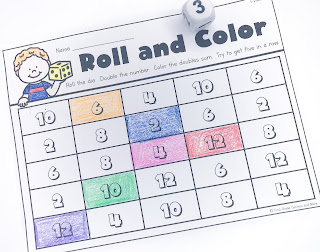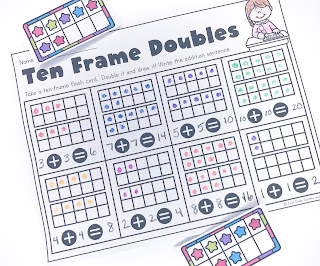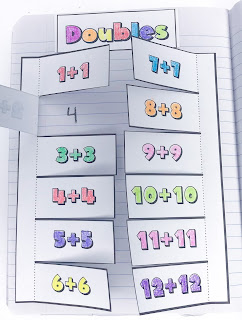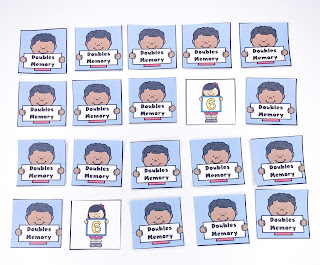Doubles Facts in Math
Increasing students' fact fluency is an important goal in first grade! For a small group of students memorizing addition and subtraction facts comes easy. But most kids need a considerable amount of time and practice in order to become fluent with addition and subtraction facts to ten. Today, I want to share some ideas for helping students to practice doubles facts. Doubles are a great place to start for increasing fact fluency and is also a precursor to learning the "doubles +1" strategy.
Dice Games
Kids love using dice! If you haven't already, start collecting a wide assortment of dice: big, small, dots, numbers, different colors, dice within a dice, 6-sided, and specialty dice. Changing the dice is an easy way to add novelty to your math activities.
One simple math game for practicing doubles facts in math is Roll and Color. Students roll the dice and color the "double" of the number. They try to color five numbers in a row. Playing with a partner is a blast because they can block each other. Your class will want to play this game again and again!

is another simple activity for practicing doubles facts. Students roll 2 dice or a dice within a dice (pictured) until they roll a double. Then they record their double fact. This game could even be played with just a piece of notebook paper for recording their doubles. This game is fast-paced and lots of fun!
Dice Tip- Foam dice that are quiet when they are rolled are amazing! Another option is to have students roll the dice on a 9x12 felt square, which can easily be found at your local craft store.Cubes

Unifix cubes are an excellent math tool that can be used in SO many ways! They work great for practicing doubles facts in math. Give students a target sum (even number) and have them build a doubles cube model for that sum with two colors of cubes. Starting with the sum is a great way to encourage some problem-solving skills for your students.
Ten Frames
Ten frames are a powerful math tool for helping kids visualize numbers! Use doubles facts flashcards to have students build addition problems on their ten frames.
This mat is fabulous for whole or small groups. Put the mat in a write and wipe pocket or page protector for repeated practice. Students use dry erase markers to record the fact, then erase and start again.
This worksheet is great for independent practice or a math center. Kids choose a ten frame. They double the number and write the addition sentence. You can download a copy of the worksheet
here.Interactive Notebooks
An interactive notebook activity provides an opportunity for students to review their work. They will love to revisit their notebook and practice their doubles!
Dominoes
Dominoes are another great tool for visualization! Have your students dig through sets of dominoes looking for doubles. Then have them record the pairs of doubles facts.
Games!
Kids love anything that feels like a game instead of work! Here are a couple of game ideas for you.
Memory Match: Students find matching numerals. Then they tell the doubles fact. You could use something as simple as a deck of playing cards for this activity.
Puzzles are another game option. The best part- they are self-checking! Consider adding in a recording sheet for accountability
Math Links:
First-graders love math links! They are also a great way to continue to develop fine-motor skills. Have students build doubles addition facts with the links. Then they can attach the problem and the sum.
I hope this gave you some ideas of activities you can do in your classroom to help students learn their doubles facts in math and build their addition fluency. If you would like to learn more about this resource, you can click the picture below.
loading..






















No comments